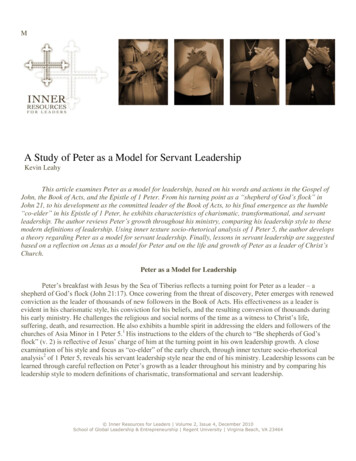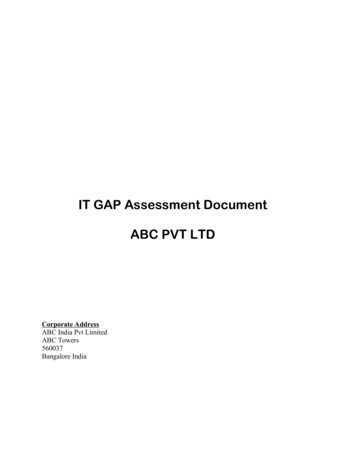
Transcription
Undergraduate Texts in MathematicsPeter J. Olver · Chehrzad ShakibanAppliedLinearAlgebraSecond Edition
Undergraduate Texts in Mathematics
Undergraduate Texts in MathematicsSeries Editors:Sheldon AxlerSan Francisco State University, San Francisco, CA, USAKenneth RibetUniversity of California, Berkeley, CA, USAAdvisory Board:Colin Adams, Williams CollegeDavid A. Cox, Amherst CollegeL. Craig Evans, University of California, BerkeleyPamela Gorkin, Bucknell UniversityRoger E. Howe, Yale UniversityMichael Orrison, Harvey Mudd CollegeLisette G. de Pillis, Harvey Mudd CollegeJill Pipher, Brown UniversityFadil Santosa, University of MinnesotaUndergraduate Texts in Mathematics are generally aimed at third- and fourth-year undergraduatemathematics students at North American universities. These texts strive to provide students and teacherswith new perspectives and novel approaches. The books include motivation that guides the reader toan appreciation of interrelations among different aspects of the subject. They feature examples thatillustrate key concepts as well as exercises that strengthen understanding.More information about this series at http://www.springer.com/series/666
Peter J. Olver Chehrzad ShakibanApplied Linear AlgebraSecond Edition
Peter J. OlverSchool of MathematicsUniversity of MinnesotaMinneapolis, MNUSAChehrzad ShakibanDepartment of MathematicsUniversity of St. ThomasSt. Paul, MNUSAISSN 0172-6056ISSN 2197-5604 (electronic)Undergraduate Texts in MathematicsISBN 978-3-319-91040-6ISBN 978-3-319-91041-3 brary of Congress Control Number: 2018941541Mathematics Subject Classification (2010): 15-01, 15AXX, 65FXX, 05C50, 34A30, 62H25, 65D05, 65D07, 65D181st edition: 2006 Pearson Education, Inc., Pearson Prentice Hall, Pearson Education, Inc., Upper Saddle River, NJ 074582nd edition: Springer International Publishing AG, part of Springer Nature 2018This work is subject to copyright. All rights are reserved by the Publisher, whether the whole or part of the material isconcerned, specifically the rights of translation, reprinting, reuse of illustrations, recitation, broadcasting, reproduction onmicrofilms or in any other physical way, and transmission or information storage and retrieval, electronic adaptation,computer software, or by similar or dissimilar methodology now known or hereafter developed.The use of general descriptive names, registered names, trademarks, service marks, etc. in this publication does not imply,even in the absence of a specific statement, that such names are exempt from the relevant protective laws and regulations andtherefore free for general use.The publisher, the authors and the editors are safe to assume that the advice and information in this book are believed to betrue and accurate at the date of publication. Neither the publisher nor the authors or the editors give a warranty, express orimplied, with respect to the material contained herein or for any errors or omissions that may have been made. The publisherremains neutral with regard to jurisdictional claims in published maps and institutional affiliations.Printed on acid-free paperThis Springer imprint is published by the registered company Springer International Publishing AG part of Springer Nature.The registered company address is: Gewerbestrasse 11, 6330 Cham, Switzerland
To our children and grandchildren.You are the light of our life.
PrefaceApplied mathematics rests on two central pillars: calculus and linear algebra. While calculus has its roots in the universal laws of Newtonian physics, linear algebra arises from amuch more mundane issue: the need to solve simple systems of linear algebraic equations.Despite its humble origins, linear algebra ends up playing a comparably profound role inboth applied and theoretical mathematics, as well as in all of science and engineering,including computer science, data analysis and machine learning, imaging and signal processing, probability and statistics, economics, numerical analysis, mathematical biology,and many other disciplines. Nowadays, a proper grounding in both calculus and linear algebra is an essential prerequisite for a successful career in science, technology, engineering,statistics, data science, and, of course, mathematics.Since Newton, and, to an even greater extent following Einstein, modern science hasbeen confronted with the inherent nonlinearity of the macroscopic universe. But most ofour insight and progress is based on linear approximations. Moreover, at the atomic level,quantum mechanics remains an inherently linear theory. (The complete reconciliationof linear quantum theory with the nonlinear relativistic universe remains the holy grailof modern physics.) Only with the advent of large-scale computers have we been ableto begin to investigate the full complexity of natural phenomena. But computers relyon numerical algorithms, and these in turn require manipulating and solving systems ofalgebraic equations. Now, rather than just a handful of equations, we may be confrontedby gigantic systems containing thousands (or even millions) of unknowns. Without thediscipline of linear algebra to formulate systematic, efficient solution algorithms, as wellas the consequent insight into how to proceed when the numerical solution is insufficientlyaccurate, we would be unable to make progress in the linear regime, let alone make senseof the truly nonlinear physical universe.Linear algebra can thus be viewed as the mathematical apparatus needed to solve potentially huge linear systems, to understand their underlying structure, and to apply whatis learned in other contexts. The term “linear” is the key, and, in fact, it refers not justto linear algebraic equations, but also to linear differential equations, both ordinary andpartial, linear boundary value problems, linear integral equations, linear iterative systems,linear control systems, and so on. It is a profound truth that, while outwardly different,all linear systems are remarkably similar at their core. Basic mathematical principles suchas linear superposition, the interplay between homogeneous and inhomogeneous systems,the Fredholm alternative characterizing solvability, orthogonality, positive definiteness andminimization principles, eigenvalues and singular values, and linear iteration, to name buta few, reoccur in surprisingly many ostensibly unrelated contexts.In the late nineteenth and early twentieth centuries, mathematicians came to the realization that all of these disparate techniques could be subsumed in the edifice now knownas linear algebra. Understanding, and, more importantly, exploiting the apparent similarities between, say, algebraic equations and differential equations, requires us to becomemore sophisticated — that is, more abstract — in our mode of thinking. The abstractionvii
viiiPrefaceprocess distills the essence of the problem away from all its distracting particularities, and,seen in this light, all linear systems rest on a common mathematical framework. Don’t beafraid! Abstraction is not new in your mathematical education. In elementary algebra,you already learned to deal with variables, which are the abstraction of numbers. Later,the abstract concept of a function formalized particular relations between variables, saydistance, velocity, and time, or mass, acceleration, and force. In linear algebra, the abstraction is raised to yet a further level, in that one views apparently different types of objects(vectors, matrices, functions, . . . ) and systems (algebraic, differential, integral, . . . ) in acommon conceptual framework. (And this is by no means the end of the mathematicalabstraction process; modern category theory, [37], abstractly unites different conceptualframeworks.)In applied mathematics, we do not introduce abstraction for its intrinsic beauty. Ourultimate purpose is to develop effective methods and algorithms for applications in science,engineering, computing, statistics, data science, etc. For us, abstraction is driven by theneed for understanding and insight, and is justified only if it aids in the solution to realworld problems and the development of analytical and computational tools. Whereas to thebeginning student the initial concepts may seem designed merely to bewilder and confuse,one must reserve judgment until genuine applications appear. Patience and perseveranceare vital. Once we have acquired some familiarity with basic linear algebra, significant,interesting applications will be readily forthcoming. In this text, we encounter graph theoryand networks, mechanical structures, electrical circuits, quantum mechanics, the geometryunderlying computer graphics and animation, signal and image processing, interpolationand approximation, dynamical systems modeled by linear differential equations, vibrations,resonance, and damping, probability and stochastic processes, statistics, data analysis,splines and modern font design, and a range of powerful numerical solution algorithms, toname a few. Further applications of the material you learn here will appear throughoutyour mathematical and scientific career.This textbook has two interrelated pedagogical goals. The first is to explain basictechniques that are used in modern, real-world problems. But we have not written a meremathematical cookbook — a collection of linear algebraic recipes and algorithms. Webelieve that it is important for the applied mathematician, as well as the scientist andengineer, not just to learn mathematical techniques and how to apply them in a varietyof settings, but, even more importantly, to understand why they work and how they arederived from first principles. In our approach, applications go hand in hand with theory,each reinforcing and inspiring the other. To this end, we try to lead the reader through thereasoning that leads to the important results. We do not shy away from stating theoremsand writing out proofs, particularly when they lead to insight into the methods and theirrange of applicability. We hope to spark that eureka moment, when you realize “Yes,of course! I could have come up with that if I’d only sat down and thought it out.”Most concepts in linear algebra are not all that difficult at their core, and, by graspingtheir essence, not only will you know how to apply them in routine contexts, you willunderstand what may be required to adapt to unusual or recalcitrant problems. And, thefurther you go on in your studies or work, the more you realize that very few real-worldproblems fit neatly into the idealized framework outlined in a textbook. So it is (applied)mathematical reasoning and not mere linear algebraic technique that is the core and raisond’être of this text!Applied mathematics can be broadly divided into three mutually reinforcing components. The first is modeling — how one derives the governing equations from physical
Prefaceixprinciples. The second is solution techniques and algorithms — methods for solving themodel equations. The third, perhaps least appreciated but in many ways most important,are the frameworks that incorporate disparate analytical methods into a few broad themes.The key paradigms of applied linear algebra to be covered in this text include Gaussian Elimination and factorization of matrices;linearity and linear superposition;span, linear independence, basis, and dimension;inner products, norms, and inequalities;compatibility of linear systems via the Fredholm alternative;positive definiteness and minimization principles;orthonormality and the Gram–Schmidt process;least squares solutions, interpolation, and approximation;linear functions and linear and affine transformations;eigenvalues and eigenvectors/eigenfunctions;singular values and principal component analysis;linear iteration, including Markov processes and numerical solution schemes;linear systems of ordinary differential equations, stability, and matrix exponentials;vibrations, quasi-periodicity, damping, and resonance; .These are all interconnected parts of a very general applied mathematical edifice of remarkable power and practicality. Understanding such broad themes of applied mathematics isour overarching objective. Indeed, this book began life as a part of a much larger work,whose goal is to similarly cover the full range of modern applied mathematics, both linear and nonlinear, at an advanced undergraduate level. The second installment is now inprint, as the first author’s text on partial differential equations, [61], which forms a natural extension of the linear analytical methods and theoretical framework developed here,now in the context of the equilibria and dynamics of continuous media, Fourier analysis,and so on. Our inspirational source was and continues to be the visionary texts of GilbertStrang, [79, 80]. Based on students’ reactions, our goal has been to present a more linearlyordered and less ambitious development of the subject, while retaining the excitement andinterconnectedness of theory and applications that is evident in Strang’s works.Syllabi and PrerequisitesThis text is designed for three potential audiences: A beginning, in-depth course covering the fundamentals of linear algebra and its applications for highly motivated and mathematically mature students. A second undergraduate course in linear algebra, with an emphasis on those methodsand concepts that are important in applications. A beginning graduate-level course in linear mathematics for students in engineering,physical science, computer science, numerical analysuis, statistics, and even mathematical biology, finance, economics, social sciences, and elsewhere, as well asmaster’s students in applied mathematics.Although most students reading this book will have already encountered some basiclinear algebra — matrices, vectors, systems of linear equations, basic solution techniques,etc. — the text makes no such assumptions. Indeed, the first chapter starts at the verybeginning by introducing linear algebraic systems, matrices, and vectors, followed by very
xPrefacebasic Gaussian Elimination. We do assume that the reader has taken a standard twoyear calculus sequence. One-variable calculus — derivatives and integrals — will be usedwithout comment; multivariable calculus will appear only fleetingly and in an inessentialway. The ability to handle scalar, constant coefficient linear ordinary differential equationsis also assumed, although we do briefly review elementary solution techniques in Chapter 7.Proofs by induction will be used on occasion. But the most essential prerequisite is acertain degree of mathematical maturity and willingness to handle the increased level ofabstraction that lies at the heart of contemporary linear algebra.Survey of TopicsIn addition to introducing the fundamentals of matrices, vectors, and Gaussian Eliminationfrom the beginning, the initial chapter delves into perhaps less familiar territory, such asthe (permuted) L U and L D V decompositions, and the practical numerical issues underlying the solution algorithms, thereby highlighting the computational efficiency of GaussianElimination coupled with Back Substitution versus methods based on the inverse matrixor determinants, as well as the use of pivoting to mitigate possibly disastrous effects ofnumerical round-off errors. Because the goal is to learn practical algorithms employedin contemporary applications, matrix inverses and determinants are de-emphasized —indeed, the most efficient way to compute a determinant is via Gaussian Elimination,which remains the key algorithm throughout the initial chapters.Chapter 2 is the heart of linear algebra, and a successful course rests on the students’ability to assimilate the absolutely essential concepts of vector space, subspace, span, linearindependence, basis, and dimension. While these ideas may well have been encounteredin an introductory ordinary differential equation course, it is rare, in our experience, thatstudents at this level are at all comfortable with them. The underlying mathematics is notparticularly difficult, but enabling the student to come to grips with a new level of abstraction remains the most challenging aspect of the course. To this end, we have included awide range of illustrative examples. Students should start by making sure they understandhow a concept applies to vectors in Euclidean space R n before pressing on to less familiar territory. While one could design a course that completely avoids infinite-dimensionalfunction spaces, we maintain that, at this level, they should be integrated into the subjectright from the start. Indeed, linear analysis and applied mathematics, including Fouriermethods, boundary value problems, partial differential equations, numerical solution techniques, signal processing, control theory, modern physics, especially quantum mechanics,and many, many other fields, both pure and applied, all rely on basic vector space constructions, and so learning to deal with the full range of examples is the secret to futuresuccess. Section 2.5 then introduces the fundamental subspaces associated with a matrix— kernel (null space), image (column space), coimage (row space), and cokernel (left nullspace) — leading to what is known as the Fundamental Theorem of Linear Algebra whichhighlights the remarkable interplay between a matrix and its transpose. The role of thesespaces in the characterization of solutions to linear systems, e.g., the basic superpositionprinciples, is emphasized. The final Section 2.6 covers a nice application to graph theory,in preparation for later developments.Chapter 3 discusses general inner products and norms, using the familiar dot productand Euclidean distance as motivational examples. Again, we develop both the finitedimensional and function space cases in tandem. The fundamental Cauchy–Schwarz inequality is easily derived in this abstract framework, and the more familiar triangle in-
Prefacexiequality, for norms derived from inner products, is a simple consequence. This leads tothe definition of a general norm and the induced matrix norm, of fundamental importancein iteration, analysis, and numerical methods. The classification of inner products on Euclidean space leads to the important class of positive definite matrices. Gram matrices,constructed out of inner products of elements of inner product spaces, are a particularlyfruitful source of positive definite and semi-definite matrices, and reappear throughout thetext. Tests for positive definiteness rely on Gaussian Elimination and the connections between the L D LT factorization of symmetric matrices and the process of completing thesquare in a quadratic form. We have deferred treating complex vector spaces until thefinal section of this chapter — only the definition of an inner product is not an evidentadaptation of its real counterpart.Chapter 4 exploits the many advantages of orthogonality. The use of orthogonal andorthonormal bases creates a dramatic speed-up in basic computational algorithms. Orthogonal matrices, constructed out of orthogonal bases, play a major role, both in geometryand graphics, where they represent rigid rotations and reflections, as well as in notablenumerical algorithms. The orthogonality of the fundamental matrix subspaces leads to alinear algebraic version of the Fredholm alternative for compatibility of linear systems. Wedevelop several versions of the basic Gram–Schmidt process for converting an arbitrarybasis into an orthogonal basis, used in particular to construct orthogonal polynomials andfunctions. When implemented on bases of R n , the algorithm becomes the celebrated Q Rfactorization of a nonsingular matrix. The final section surveys an important application tocontemporary signal and image processing: the discrete Fourier representation of a sampledsignal, culminating in the justly famous Fast Fourier Transform.Chapter 5 is devoted to solving the most basic multivariable minimization problem:a quadratic function of several variables. The solution is reduced, by a purely algebraiccomputation, to a linear system, and then solved in practice by, for example, GaussianElimination. Applications include finding the closest element of a subspace to a givenpoint, which is reinterpreted as the orthogonal projection of the element onto the subspace,and results in the least squares solution to an incompatible linear system. Interpolationof data points by polynomials, trigonometric function, splines, etc., and least squares approximation of discrete data and continuous functions are thereby handled in a commonconceptual framework.Chapter 6 covers some striking applications of the preceding developments in mechanicsand electrical circuits. We introduce a general mathematical structure that governs a widerange of equilibrium problems. To illustrate, we start with simple mass–spring chains,followed by electrical networks, and finish by analyzing the equilibrium configurations andthe stability properties of general structures. Extensions to continuous mechanical andelectrical systems governed by boundary value problems for ordinary and partial differentialequations can be found in the companion text [61].Chapter 7 delves into the general abstract foundations of linear algebra, and includessignificant applications to geometry. Matrices are now viewed as a particular instanceof linear functions between vector spaces, which also include linear differential operators,linear integral operators, quantum mechanical operators, and so on. Basic facts about linearsystems, such as linear superposition and the connections between the homogeneous andinhomogeneous systems, which were already established in the algebraic context, are shownto be of completely general applicability. Linear functions and slightly more general affinefunctions on Euclidean space represent basic geometrical transformations — rotations,shears, translations, screw motions, etc. — and so play an essential role in modern computer
xiiPrefacegraphics, movies, animation, gaming, design, elasticity, crystallography, symmetry, etc.Further, the elementary transpose operation on matrices is viewed as a particular caseof the adjoint operation on linear functions between inner product spaces, leading to ageneral theory of positive definiteness that characterizes solvable quadratic minimizationproblems, with far-reaching consequences for modern functional analysis, partial differentialequations, and the calculus of variations, all fundamental in physics and mechanics.Chapters 8–10 are concerned with eigenvalues and their many applications, including data analysis, numerical methods, and linear dynamical systems, both continuousand discrete. After motivating the fundamental definition of eigenvalue and eigenvectorthrough the quest to solve linear systems of ordinary differential equations, the remainderof Chapter 8 develops the basic theory and a range of applications, including eigenvectorbases, diagonalization, the Schur decomposition, and the Jordan canonical form. Practicalcomputational schemes for determining eigenvalues and eigenvectors are postponed untilChapter 9. The final two sections cover the singular value decomposition and principalcomponent analysis, of fundamental importance in modern statistical analysis and datascience.Chapter 9 employs eigenvalues to analyze discrete dynamics, as governed by linear iterative systems. The formulation of their stability properties leads us to define the spectralradius and further develop matrix norms. Section 9.3 contains applications to Markovchains arising in probabilistic and stochastic processes. We then discuss practical alternatives to Gaussian Elimination for solving linear systems, including the iterative Jacobi,Gauss–Seidel, and Successive Over–Relaxation (SOR) schemes, as well as methods for computing eigenvalues and eigenvectors including the Power Method and its variants, and thestriking Q R algorithm, including a new proof of its convergence. Section 9.6 introducesmore recent semi-direct iterative methods based on Krylov subspaces that are increasinglyemployed to solve the large sparse linear systems arising in the numerical solution of partialdifferential equations and elsewhere: Arnoldi and Lanczos methods, Conjugate Gradients(CG), the Full Orthogonalization Method (FOM), and the Generalized Minimal ResidualMethod (GMRES). The chapter concludes with a short introduction to wavelets, a powerful modern alternative to classical Fourier analysis, now used extensively throughout signalprocessing and imaging science.The final Chapter 10 applies eigenvalues to linear dynamical systems modeled by systemsof ordinary differential equations. After developing basic solution techniques, the focusshifts to understanding the qualitative properties of solutions and particularly the roleof eigenvalues in the stability of equilibria. The two-dimensional case is discussed in fulldetail, culminating in a complete classification of the possible phase portraits and stabilityproperties. Matrix exponentials are introduced as an alternative route to solving first orderhomogeneous systems, and are also applied to solve the inhomogeneous version, as well asto geometry, symmetry, and group theory. Our final topic is second order linear systems,which model dynamical motions and vibrations in mechanical structures and electricalcircuits. In the absence of frictional damping and instabilities, solutions are quasiperiodiccombinations of the normal modes. We finish by briefly discussing the effects of dampingand of periodic forcing, including its potentially catastrophic role in resonance.Course OutlinesOur book includes far more material than can be comfortably covered in a single semester;a full year’s course would be able to do it justice. If you do not have this luxury, several
Prefacexiiipossible semester and quarter courses can be extracted from the wealth of material andapplications.First, the core of basic linear algebra that all students should know includes the followingtopics, which are indexed by the section numbers where they appear: Matrices, vectors, Gaussian Elimination, matrix factorizations, Forward andBack Substitution, inverses, determinants: 1.1–1.6, 1.8–1.9. Vector spaces, subspaces, linear independence, bases, dimension: 2.1–2.5. Inner products and their associated norms: 3.1–3.3. Orthogonal vectors, bases, matrices, and projections: 4.1–4.4. Positive definite matrices and minimization of quadratic functions: 3.4–3.5, 5.2 Linear functions and linear and affine transformations: 7.1–7.3. Eigenvalues and eigenvectors: 8.2–8.3. Linear iterative systems: 9.1–9.2.With these in hand, a variety of thematic threads can be extracted, including: Minimization, least squares, data fitting and interpolation: 4.5, 5.3–5.5.Dynamical systems: 8.4, 8.6 (Jordan canonical form), 10.1–10.4.Engineering applications: Chapter 6, 10.1–10.2, 10.5–10.6.Data analysis: 5.3–5.5, 8.5, 8.7–8.8.Numerical methods: 8.6 (Schur decomposition), 8.7, 9.1–9.2, 9.4–9.6.Signal processing: 3.6, 5.6, 9.7.Probabilistic and statistical applications: 8.7–8.8, 9.3.Theoretical foundations of linear algebra: Chapter 7.For a first semester or quarter course, we recommend covering as much of the coreas possible, and, if time permits, at least one of the threads, our own preference beingthe material on structures and circuits. One option for streamlining the syllabus is toconcentrate on finite-dimensional vector spaces, bypassing the function space material,although this would deprive the students of important insight into the full scope of linearalgebra.For a second course in linear algebra, the students are typically familiar with elementary matrix methods, including the basics of matrix arithmetic, Gaussian Elimination,determinants, inverses, dot product and Euclidean norm, eigenvalues, and, often, first order systems of ordinary differential equations. Thus, much of Chapter 1 can be reviewedquickly. On the other hand, the more abstract fundamentals, including vector spaces, span,linear independence, basis, and dimension are, in our experience, still not fully mastered,and one should expect to spend a significant fraction of the early part of the course coveringthese essential topics from Chapter 2 in full detail. Beyond the core material, there shouldbe time for a couple of the indicated threads depending on the audience and interest of theinstructor.Similar considerations hold for a beginning graduate level course for scientists and engineers. Here, the emphasis should be on applications required by the students, particularlynumerical methods and data analysis, and function spaces should be firmly built into theclass from the outset. As always, the students’ mastery of the first five sections of Chapter 2remains of paramount importance.
xivPrefaceComments on Individual ChaptersChapter 1 : On the assumption that the students have already seen matrices, vectors,Gaussian Elimination, inverses, and determinants, most of this material will be review andshould be covered at a fairly rapid pace. On the other hand, the L U decomposition and theemphasis on solution techniques centered on Forward and Back Substitution, in contrast toimpractical schemes involving matrix inverses and determinants, might be new. Sections1.7, on the practical/numerical aspects of Gaussian Elimination, is optional.Chapter 2 : The crux of the course. A key decision is whether to incorporate infinitedimensional vector spaces, as is recommended and done in the text, or to have an abbreviated syllabus that covers only finite-dimensional spaces, or, even more restrictively, onlyR n and subspaces thereof. The last section, on graph theory, can be skipped unless youplan on covering Chapter 6 and (parts of) the final sections of Chapters 9 and 10.Chapter 3 : Inner products and positive defini
discipline of linear algebra to formulate systematic, efficient solution algorithms, as well . interconnectedness of theory and applications that is evident in Strang's works. Syllabi and Prerequisites This text is designed for three potential audiences: A beginning, in-depth course covering the fundamentals of linear algebra and its .










